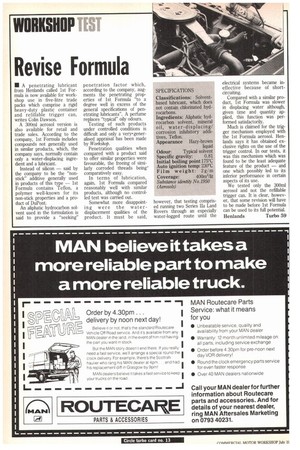Revise Formula
Page 112

If you've noticed an error in this article please click here to report it so we can fix it.
IN A penetrating lubricant from Henlands called 1st Formula is now available for workshop use in five-litre trade packs which comprise a rigid heavy-duty plastic container and refillable trigger can, writes Colin Dawson.
A 300m1 aerosol version is also available for retail and trade sales. According to the company, 1st Formula includes compounds not generally used in similar products, which, the company says, normally contain only a water-displacing ingredient and a lubricant.
Instead of silicon — said by the company to be the "nonstick" additive generally used in products of this type — 1st Formula contains Teflon, a polymer well-known for its non-stick properties and a product of DuPont.
An aliphatic hydrocarbon solvent used in the formulation is said to provide a "seeking" penetration factor which, according to the company, augments the penetrating properties of 1st Formula to a degree well in excess of the general specifications of penetrating lubricants". A perfume replaces "typical" oily odours.
Testing of such products under controlled conditions is difficult and only a verpgeneralised appraisal has been made by Workshop.
Penetration qualities when compared with a product said to offer similar properties were favourable, the freeing of similarly corroded threads being' comparatively easy.
In terms of lubrication, again, 1st Formula compared reasonably well with similar products, although no controlled test was carried out.
Somewhat more disappointing were the waterdisplacement qualities of the product. It must be said, however, that testing comprised running two Series ha Land Rovers through an especially water-logged route until the
electrical systems became ineffective because of shortcircuiting.
Compared with a similar product, 1st Formula was slower in displacing water although, given time and quantity applied, this function was performed satisfactorily.
Much is claimed for the trigger mechanism employed with the 1st Formula aerosol. Henlands says it has obtained exclusive rights on the use of the trigger control. In our tests, it was this mechanism which was found to be the least adequate feature of the product — and one which possibly led to its inferior performance in certain aspects of its use.
We tested only the 300m1 aerosol and not the refillable trigger can. It is clear, however, that some revision will have to be made before 1st Formula can be used to its full potential.
Henlands Turbo 59
















































































































































